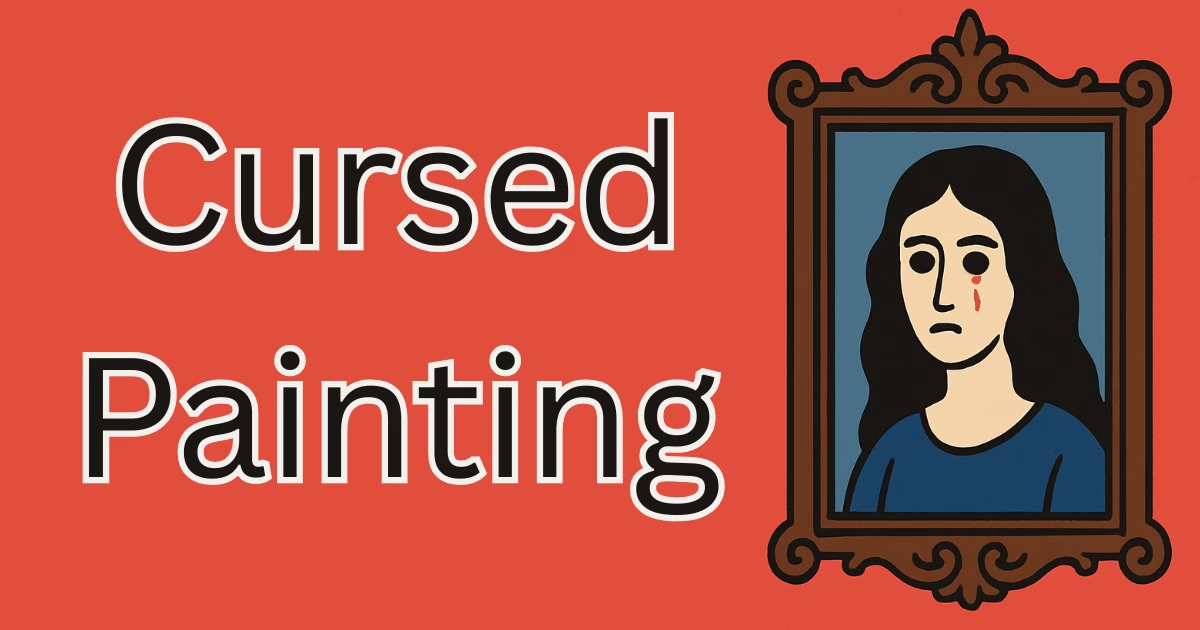There’s something chilling about a painting that stares back at you. While most art is made to inspire, some pieces seem to bring nothing but bad luck, fear, and unexplained tragedy. These are known as cursed paintings. Across the world, there are stories of artworks that have caused fires, haunted homes, or brought misfortune to those who owned them. Whether it’s coincidence or something more sinister, the idea of cursed art has captured public imagination for decades. From smoky hotel walls to dusty attic finds, tales of cursed paintings have been whispered from generation to generation. But are these just ghost stories? Or is there a darker truth behind the canvas? In this blog post, we’ll explore the most infamous cursed paintings, the history behind them, and why some people still fear hanging certain artworks on their walls.
What Is a Cursed Painting?
A cursed painting is more than just creepy—it’s believed to carry a supernatural energy or force that brings harm, bad luck, or eerie disturbances to those who own or view it. These aren’t just rumors made up for movies. Some paintings have actual stories of fires, deaths, or psychological distress tied to them.
People often describe cursed paintings as having eyes that follow you, expressions that change over time, or a strange feeling of being watched. In many cases, owners claim the paintings moved on their own, caused nightmares, or made pets behave strangely.
The belief in cursed artwork often goes back centuries, rooted in folklore and religious superstition. Sometimes it’s the artist’s tragic past, or the materials used—like animal blood or human ashes—that make people believe a painting is cursed. But what makes a painting feel “haunted” isn’t always easy to explain.
Most Famous Cursed Paintings in History
Throughout history, many paintings have gained terrifying reputations. Whether based on firsthand accounts or urban legend, these cursed artworks continue to frighten people to this day.
The Crying Boy Painting
One of the most widely known cursed paintings is “The Crying Boy,” created by Italian artist Giovanni Bragolin. The image of a teary-eyed child might seem innocent, but after a series of mysterious house fires in the 1980s, this artwork gained a disturbing reputation. In many of these fires, the homes were destroyed—but the painting was left untouched. Some claimed that anyone who owned a copy of this painting would soon experience disaster. Firefighters even started warning people about it. Though experts blamed the survival on the painting’s varnish, the curse rumors remain strong.
The Hands Resist Him
Known as the “eBay haunted painting,” “The Hands Resist Him” by Bill Stoneham first appeared online in 2000. The painting shows a young boy standing next to a life-sized doll, with several ghostly hands pressing against a glass door behind them. According to those who owned it, the painting caused nausea, fainting, and even made viewers feel watched. One seller claimed the figures moved at night, and people who viewed the listing reported strange experiences. Though the artist confirmed it wasn’t cursed, the chilling stories persist.
The Anguished Man
“The Anguished Man” might be one of the creepiest cursed paintings ever. The anonymous artist reportedly mixed his own blood into the paint before taking his own life. The painting was passed down through a family, and soon after, terrifying events began—whispers, shadow figures, and doors slamming shut. The owner recorded some of the activity and posted it online, fueling belief in its curse. Many believe the painting is possessed or acts as a portal to another realm.
Portrait of Bernardo de Gálvez
This painting hangs in a hotel in Galveston, Texas, and is rumored to be cursed. Guests and staff say the portrait’s eyes follow them. Even spookier, cameras often malfunction when trying to take a picture of it. Some believe General Bernardo de Gálvez, the man in the portrait, does not like being photographed without permission. The hotel has even posted a sign warning guests to ask the painting for permission before snapping a photo.
Other Lesser-Known Cursed Paintings
There are dozens of other artworks believed to be cursed. From a self-portrait by a disturbed artist in Spain to abstract pieces blamed for depression and illness, the stories go on. Many of these paintings end up in basements or hidden away, with owners too afraid to destroy them but too scared to display them.
Why Do People Believe in Haunted Paintings?
Belief in haunted paintings is often tied to our natural fear of the unknown. When strange events happen—especially in the presence of eerie art—people look for explanations. A cursed painting becomes a convenient answer.
Psychologists say that the human brain looks for patterns, even when none exist. This tendency, called pareidolia, helps explain why some people believe eyes in a painting are following them. Add media reports, horror films, and personal experiences, and it’s easy to see why people believe.
Also, when a painting has a dark origin—such as the artist dying suddenly or using strange materials—it adds fuel to the curse theory. Personal bias, fear, and superstition all combine to create lasting legends.
Real or Myth? The Debate Around Cursed Paintings
Not everyone believes in cursed paintings. Skeptics say most of the stories can be explained by coincidence, faulty wiring, or active imaginations. Still, believers argue that too many people have reported strange happenings for it to all be fake.
Some art collectors take the stories seriously and refuse to hang certain pieces. Others are drawn to the thrill. Museums have also displayed so-called cursed art with warning signs or special protection.
In many cases, the debate comes down to personal belief. Science hasn’t proven the existence of curses, but fear can be powerful—and very real for those affected.
Can You Own a Cursed Painting?
Yes, but would you really want to? Many cursed paintings still exist today. Some are in private collections, while others show up on auction sites. Some buyers look for them on purpose, hoping to experience the paranormal.
Owners of cursed paintings have shared warnings online. Some report sleep disturbances, constant accidents, or bad energy in the home. There are even stories of owners begging spiritual workers to remove curses or lock the artwork away.
If you ever find a painting that gives you a bad feeling, trust your instincts. Whether the curse is real or not, your reaction might be enough reason to stay away.
Final Thoughts on the Power of a Cursed Painting
Cursed paintings might sound like fiction, but for many people, the fear they bring is very real. Whether it’s the tragic backstory, strange materials, or simply a creepy expression, some artwork seems to hold more than just paint.
While science doesn’t support the idea of a cursed painting, the stories are powerful enough to keep the legends alive. These tales remind us that art isn’t always comforting. Sometimes, it stares back—and leaves a mark far deeper than brushstrokes.
So the next time you see an old painting at a garage sale or antique store, take a closer look. You never know what kind of history—or curse—it might carry.
Also Read: New Careers: Jobs That Didn’t Exist Ten Years Ago
FAQs
1. What is a cursed painting?
A cursed painting is a piece of art believed to bring bad luck, fear, or strange events to those who own or view it.
2. Is “The Crying Boy” really cursed?
Many believe it is, especially after several house fires left the painting untouched. But no one has ever proven it’s truly cursed.
3. Can cursed paintings harm you?
There’s no scientific proof, but some people report nightmares, bad luck, or feeling watched after owning certain paintings.
4. Where can I see a cursed painting?
Some cursed paintings are kept in museums or private collections. Others pop up on online auction sites or haunted locations.
5. Should I avoid buying strange or creepy artwork?
If a painting gives you a bad feeling or has a dark history, it might be best to trust your gut and leave it alone.

Hi, I’m Shafy Ali – a curious mind and passionate writer at Celiac Magazine. I cover a little bit of everything, from everyday tips and how-tos to deeper dives into topics that spark conversation. I enjoy turning research into readable, relatable content that informs and inspires. Whatever the subject, I aim to keep it clear, engaging, and genuinely useful.

